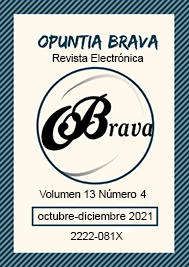Emilio Ballagas' Tenth and its importance for Cuban literature
Keywords:
literature, décima, national identity, Emilio Ballagas, stylistic and semantic analysis.Abstract
The décima is a verse full of symbolism and folklore for the culture and identity of our nation. Its communicative, aesthetic and melodic value allows it to be adapted to different expressive modalities, such as the singing of tonadas, poetic improvisation and literature. In this sense, this verse stands out in the literary production of numerous Cuban writers, among them the Camagüeyan poet Emilio Ballagas, one of the most outstanding authors in the Latin American lyric of the 20th century. Therefore, the present work aims to carry out the stylistic and semantic analysis of the décimas written by Ballagas to show the characteristics of the verses, the aesthetic, cultural values, the idiomatic and lexical turns, as well as the significance of this stanza in the work of the bard, which allows to particularize in his poetic style. In this way, the importance of the décima for Cuban literature is highlighted and the cultivation and reading of this poetic composition in the new generations is encouraged.
Downloads
References
Ballagas, E. (1984). Obra Poética. La Habana: Letras Cubanas.
Batista, M. (2015). La décima en la identidad cubana. Las Tunas: Editorial Académica Universitaria (Edacun). Recuperado de http://edacunob.ult.edu.cu
Castillo, Y. (2015). La décima oral improvisada: su contribución al desarrollo de la competencia léxica de los niños que integran el Taller de repentismo infantil “El Cucalambé” (trabajo de diploma inédito). Universidad de Oriente, Santiago de Cuba, Cuba.
Curbeira, A. (2010). Lecturas de Semántica I. La Habana: Félix Varela.
De Balboa, S. (1834). Espejo de paciencia. La Habana. Recuperado de http://hist.bayamo.ohc.cu
Fabelo, M. (2009). Emilio Ballagas, ¿el poeta olvidado? Recuperado de www.radiorebelde.cu/noticias/cultural/cultural3-110909.html
González, W. (2011). La poesía (lírica y popular) de Emilio Ballagas. Recuperado de www.anterior.palabrabierta.com/uncategorized/la-poesia-lirica-y-popular-de-emilio-ballagas
Guanche, J. (1999). España en la savia de Cuba. La Habana: Ciencias Sociales.
López, V. (2002). La décima renacentista y barroca. La Habana: Pablo de la Torriente.
Messeger, M. (2008). Emilio Ballagas, poeta de la sensualidad. Revista Luz. Recuperado de https://luz.uho.edu.cu
Montero, G. y Jevey, Á. F. (2018). Tratamiento del análisis semiótico del texto poético en el proceso de enseñanza-aprendizaje de la literatura. Opuntia Brava, 6(1), pp. 1-7. Recuperado de http://opuntiabrava.ult.edu.cu/index.php/opuntiabrava/article/view/324
Navarro, O. (1984). Prólogo a la antología Obra Poética. Emilio Ballagas. La Habana: Letras Cubanas.
Orta, J. (1980). Décima y Folclor. Estudio de la poesía y el cantar de los campos de Cuba. La Habana: Ediciones Unión.
Ruiza, M., Fernández, T. y Tamaro, E. (2004). Biografía de Emilio Ballagas. En Biografías y Vidas. La Enciclopedia biográfica en línea. Barcelona. Recuperado de https://www.biografiasyvidas.com/biografía/b/ballagas.htm
Sarría, L. (2012). La palabra y la llama. Poesía cubana de tema religioso en la Colonia. La Habana: UH. Universidad de La Habana.
Vitier, C. (1970). Lo cubano en la poesía. La Habana: Instituto del Libro.






















